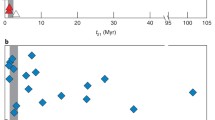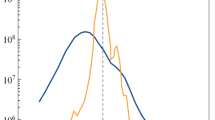Abstract
We discuss data of light noble gases from the solar wind implanted into a metallic glass target flown on the Genesis mission. Helium and neon isotopic compositions of the bulk solar wind trapped in this target during 887 days of exposure to the solar wind do not deviate significantly from the values in foils of the Apollo Solar Wind Composition experiments, which have been exposed for hours to days. In general, the depth profile of the Ne isotopic composition is similar to those often found in lunar soils, and essentially very well reproduced by ion-implantation modelling, adopting the measured velocity distribution of solar particles during the Genesis exposure and assuming a uniform isotopic composition of solar wind neon. The results confirm that contributions from high-energy particles to the solar wind fluence are negligible, which is consistent with in-situ observations. This makes the enigmatic “SEP-Ne” component, apparently present in lunar grains at relatively large depth, obsolete. 20Ne/ 22Ne ratios in gas trapped very near the metallic glass surface are up to 10% higher than predicted by ion implantation simulations. We attribute this superficially trapped gas to very low-speed, current-sheet-related solar wind, which has been fractionated in the corona due to inefficient Coulomb drag.
Similar content being viewed by others
References
J.P. Benkert, H. Baur, P. Signer, R. Wieler, J. Geophys. Res. – Planets 98, 13147 (1993)
D.C. Black, R.O. Pepin, Earth Planet. Sci. Lett. 6, 395 (1969)
R. Bodmer, P. Bochsler, Astron. Astrophys. 337, 921 (1998)
P. Bochsler, Space Sci. Rev. this volume (2007)
D.S. Burnett et al., Space Sci. Rev. 105, 509 (2003)
P. Etique, P. Signer, R. Wieler, Lunar Planet. Sci. Conf. XII (1981), pp. 265–267
J. Geiss, P. Hirt, H. Leutwyler, Sol. Phys. 12, 458 (1970)
J. Geiss et al., Space Sci. Rev. 110, 307 (2004)
A.G. Ghielmetti, H. Balsiger, R. Bänninger, P. Eberhardt, J. Geiss, D.T. Young, Rev. Sci. Instruments 54, 425 (1983)
G. Gloeckler et al., Space Sci. Rev. 86, 497 (1998)
A. Grimberg, F. Bühler, P. Bochsler, V.S. Heber, H. Baur, R. Wieler, Lunar Planet. Sci. XXXVI, abstract #1355 (2005)
A. Grimberg et al., Science 314, 1133 (2006)
V. Heber, PhD Thesis, ETH Zürich, Nr. 14579, 2002, p. 157
D. Hovestadt et al., Sol. Phys. 162, 441 (1995)
A.J.G. Jurewicz et al., Space Sci. Rev. 105, 535 (2003)
R. Kallenbach et al., J. Geophys. Res. – Space Phys. 102, 26895 (1997a)
R. Kallenbach et al., in 31st ESALAB Symposium, Correlated Phenomena at the Sun, in the Heliosphere and in Geospace (1997b), pp. 33
R. Kallenbach et al., Space Sci. Rev. 85, 357 (1998)
G.M. Mason et al., Space Sci. Rev. 86, 409 (1998)
D.J. McComas et al., Space Sci. Rev. 86, 563 (1998)
R.A. Mewaldt, R.C. Ogliore, G. Gloeckler, G.M. Mason, in R. Wimmer-Schweingruber (ed.), Solar and galactic composition. AIP Conf. Proc. 598, 393–398 (2001)
R.O. Pepin, R.H. Becker, D.J. Schlutter, Geochimica et Cosmochimica Acta 63, 2145 (1999)
R.O. Pepin, R.L. Palma, D.J. Schlutter, Meteorit. Planet. Sci. 35, 495 (2000)
D.B. Reisenfeld et al., Space Sci. Rev. this volume (2007)
C.W. Smith et al., Space Sci. Rev. 86, 613 (1998)
E.C. Stone et al., Space Sci. Rev. 86, 357 (1998a)
E.C. Stone et al., Space Sci. Rev. 96, 285 (1998b)
A.S. Tamhane, J.K. Agrawal, Earth Planet. Sci. Lett. 42, 243 (1979)
R. Wieler, Space Sci. Rev. 85, 303 (1998)
R. Wieler, H. Baur, P. Signer, Geochimica et Cosmochimica Acta 50, 1997 (1986)
R.F. Wimmer-Schweingruber, PhD Thesis, University Bern, 1994
R.F. Wimmer-Schweingruber, P. Bochsler, O. Kern, G. Gloeckler, J. Geophys. Res. 103(A9), 20621 (1998)
R.F. Wimmer-Schweingruber, P. Bochsler, in Solar and Galactic Composition. AIP Conf. Proc., ed. by R. Wimmer-Schweingruber, vol. 598 (2001), p. 399
J.F. Ziegler, Nucl. Instruments Methods Phys. Res. Sect. B 219(20), 1027 (2004)
Author information
Authors and Affiliations
Corresponding author
Rights and permissions
About this article
Cite this article
Grimberg, A., Burnett, D.S., Bochsler, P. et al. Composition of Light Solar Wind Noble Gases in the Bulk Metallic Glass flown on the Genesis Mission. Space Sci Rev 130, 293–300 (2007). https://doi.org/10.1007/s11214-007-9150-1
Received:
Accepted:
Published:
Issue Date:
DOI: https://doi.org/10.1007/s11214-007-9150-1




